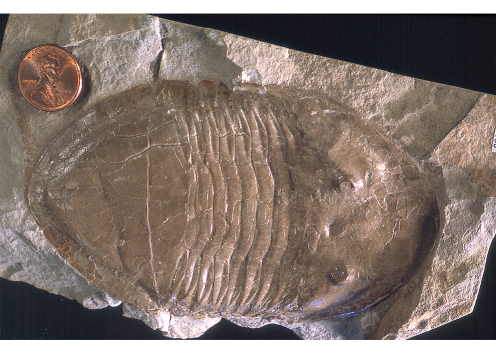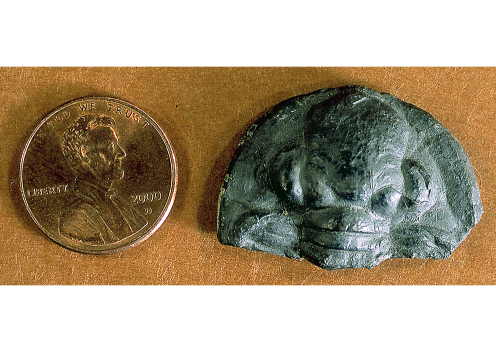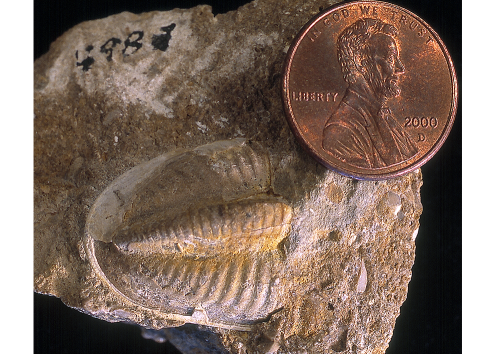Trilobites

Trilobites were some of the first multicellular animals to live in the world's oceans. Their fossil record extends back 530 million years to the early part of the Cambrian Period and indicates that trilobites evolved rapidly in the shallow seas of this time. In fact, trilobite fossils are so common in Cambrian rocks that the Cambrian Period is sometimes called the age of trilobites.
Although trilobite diversity decreased about 443 million years ago, following the major extinction event at the end of the Ordovican Period and again during a series of extinctions in the Middle to Late Devonian Period, trilobites have one of the most extensive fossil records of any group of animals. Thousands of species are known from rocks around the world, leading some to call trilobites the beetles of the Paleozoic.
Trilobite fossils are fairly rare in the Pennsylvanian and Permian rocks that crop out in eastern Kansas, a testament to the decline in their diversity during the later Paleozoic. The very last trilobites appear to have died out completely near the end of the Permian Period, just before another huge extinction that marked the end of the Paleozoic Era.
Like the insects, trilobites are classified as arthropods, animals with jointed legs. Their closest living relative is the horseshoe crab Limulus.
Trilobites had a hard external skeleton, called a carapace, which is convex and approximately oval-shaped. The carapace is divided lengthwise into three lobes (hence, the name trilobite): a prominent central axis and two flatter lobes. The carapace consists of a head, or cephalon, which is typically crescent shaped; a middle region called the thorax, made up of a number of overlapping segments (anywhere from 2 to 61); and a tail, or pygidium, in which the segments were fused. Complete trilobite carapaces can be found in rocks that were deposited in quiet-water environments, but generally the skeletal parts were scattered by currents, scavengers, or other processes.
Whether scattered or whole, trilobite skeletal parts were hard enough to have a decent survival rate. Their carapaces are made of calcium carbonate, or calcite (as are the shells of brachiopods and some clams). In addition, trilobites molted—that is, they periodically shed their external skeletons as they grew. Thus, each individual typically discarded several carapaces, increasing the chances that one of these parts might be preserved as a fossil.
Trilobite limbs, on the other hand, were not covered with calcium carbonate and are only rarely preserved as fossil impressions. From these rare fossils, we know that trilobites possessed numerous jointed limbs, one pair per segment, as well as a pair of antennae. On the thorax, each limb was divided into a walking appendage and a branch of feathery gills. Experts think that in addition to locomotion, trilobite limbs were used like a broom to sweep debris from the sea floor into suspension where it could then be drawn into the mouth and eaten.
Trilobite eyes are the oldest example of a visual system known. Trilobites had compound eyes, made up of many lenses (like those of modern insects) — and each lens was a rod made of calcite. The calcite lenses were oriented so that light passed through in straight lines, unrefracted by the transparent crystals. Trilobites undoubtedly used their eyes to elude predators and possibly to locate food and mates.
Another way many trilobites avoided being eaten was to roll themselves up into a tight ball, with their vulnerable soft parts safely tucked away inside. Some trilobites were preserved in this position, rolled up like modern pill bugs (commonly known as roly-poly bugs).
During their long history, trilobites evolved a multitude of forms. Some trilobites were spiny; some were smooth. Some had enormous eyes; others were blind. Some were tiny, about the size of a ladybird beetle; others were the size of a large serving platter, though most were about 1 to 3 inches in length.
In Kansas, the oldest rocks that crop out at the surface are from the last part of the Paleozoic, when trilobite numbers had dwindled greatly. Thus, trilobites are not common fossils in Kansas, though they are sometimes found in Pennsylvanian and Permian rocks of eastern Kansas. These Kansas fossils are records of some of the last trilobites to live on Earth.
Stratigraphic Range: Lower Cambrian to Upper Permian.
Taxonomic Classification: Trilobites belong to the Kingdom Animalia, Phylum Arthropoda, Class Trilobita.
Text and photos from Windows to the Past: A Guidebook to Common Invertebrate Fossils of Kansas, Kansas Geological Survey Educational Series 16.
Sources
Boardman, R. S., Cheetham, A. H., and Rowell, A. J., 1987, Fossil Invertebrates: Boston, Blackwell Scientific Publications, 713 p.
Clarkson, E. N. K., 1979, Invertebrate Palaeontology and Evolution, 3rd Edition: London, Chapman and Hall, 434 p.
Fortey, R., 1999, Life—A Natural History of the First Four-Billion Years of Life on Earth: New York, Knopf, 346 p.
Fortey, R., 2000, Trilobite! Eyewitness to Evolution: New York, Knopf, 284 p.
Johnson, K. B., and Stuckey, R. K., 1995, Prehistoric Journey—A History of Life on Earth: Boulder, Colorado, Denver Museum of Natural History and Roberts Rinehart Publishers, 144 p.
Kaesler, R. L., ed., 1997, Arthropoda 1—Trilobita, Revised (Introduction, Order Agnostida, Order Redlichiida), Part O, Vol. 1; in, Treatise on Invertebrate Paleontology: Boulder, Colorado, and Lawrence, Kansas, Geological Society of America and The University of Kansas, 530 p.
Whittington, H. B., 1997, Morphology of the Exoskeleton; in, Treatise on Invertebrate Paleontology, Arthropoda 1—Trilobita, Revised (Introduction, Order Agnostida, Order Redlichiida), Part O, Vol. 1, R. L. Kaesler, ed.: Boulder, Colorado, and Lawrence, Kansas, Geological Society of America and The University of Kansas, 530 p.
University of California Museum of Paleontology, 1995, Trilobita—Fossil Record (March 29, 2001).
Williams, R. B., 1975, Ancient Life Found in Kansas Rocks—An Introduction to Common Kansas Fossils: Kansas Geological Survey, Educational Series 1, 42 p.



